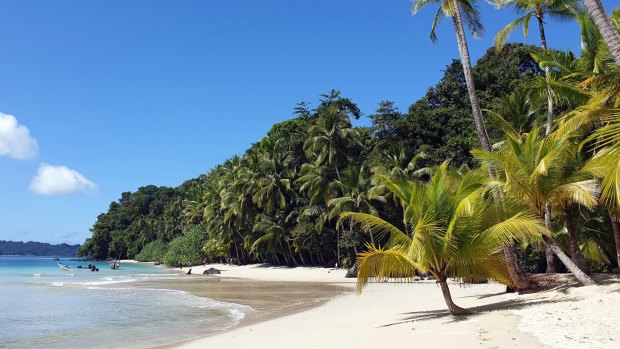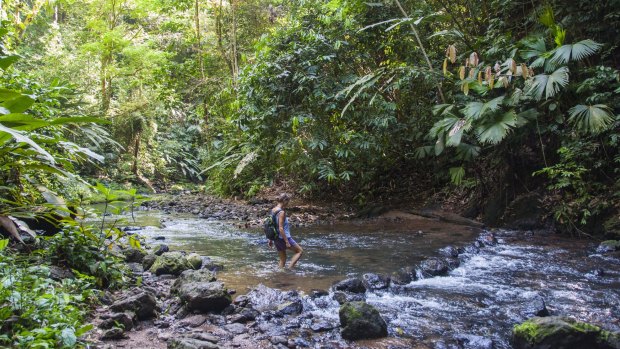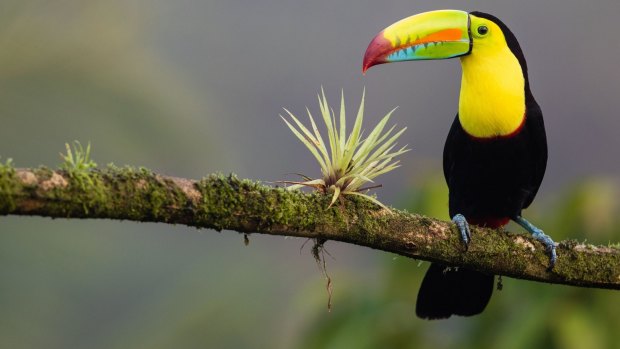Costa Rica cruise: This tiny country packs a punch

Coiba Island, which from 1919 to 2004 was home to the "Alcatraz of Panama", a high-security prison housing violent criminals and political dissidents.Credit: Aurora Expeditions
I've arrived with low expectations. Any expert will tell you that the best time to see wildlife in the tropics is in the relative cool of early morning. However, cruise passengers aren't allowed into Costa Rica's Corcovado National Park until midday, so we're starting our hike just as the heat and humidity reaches its soupy crescendo. As we follow our local guide, Caesar, along a winding dirt trail, the surrounding jungle is ominously quiet.
Suddenly, he stops, scanning the dense tangle of canopy overhead. Leaving the trail, he marches through the ferny undergrowth until we're all gathered under a towering fig tree. We look up to see a pair of fuzzy brown spider monkeys, the most elusive of the park's four monkey species, sitting in the fork of a branch, methodically preening each other. A few minutes later, he finds another of the country's wildlife superstars, a three-toed sloth, inching through the high canopy with a tiny baby clinging to its front. And then, just to prove that nature has no respect for experts, one of Costa Rica's rarest endemic birds, a black-cheeked ant-tanager, hops into view. "Wow!" exclaims Caesar. "I once spent four days looking for that bird."
For a country that's smaller than Tasmania, Costa Rica packs a mighty wildlife punch. It's home to more than 900 bird species, nearly 250 species of mammals (including about 10 per cent of the world's bat species) and more than 200 different reptiles. It's the first stop on this inaugural Aurora Expeditions voyage in Central America, a 13-day journey that will take us along the Pacific coastlines of Costa Rica and Panama before passing through the Panama Canal and finishing in Cartagena on Colombia's Caribbean coast.

Costa Rica's Corcovado National Park is home to 2.5 per cent of the world's biodiversity.Credit: iStock
During the welcome briefing on day one, expedition leader Roger Kirkwood stresses that, while we have an itinerary, things will almost certainly change. "We're exploring," he says, with a wry smile, "so plans will be flexible."
Aurora has been shepherding guests to the polar regions for 30 years, so the company is no stranger to expedition-style cruising, but this is its first foray into Central America. Onboard are several local experts, who'll provide invaluable insight into the region's wildlife, history and culture.
During the Costa Rican portion of the trip, we visit three of the country's 30 national parks, starting with Manuel Antonio National Park, where the highlight is being shadowed by a boisterous troop of white-faced capuchins. Our guide calls them the "mafia of the jungle" because of their propensity to steal food from unsuspecting tourists (hence why everyone's bags are checked at the entrance).

In Piedras Blancas National Park, we get to see more of the country's famed birdlife, including toucans.Credit: Aurora Expeditions
During an early morning hike in Piedras Blancas National Park, we get to see more of the country's famed birdlife, including toucans, kiskadees and a pair of flame-red scarlet macaws. We also sample its abundant tropical fruits, from the sweetest, juiciest pineapple I've ever tasted to the curiously fleshy innards of spiky skinned soursop. According to our guide, the monkeys in the park don't bother eating the bananas. Why would they when there are so many other delectable options on offer?
We were supposed to spend our last day in Costa Rica snorkelling in Golfo Dulce, one of only four tropical fjords on the planet. But our visit coincides with a toxic algae bloom, so instead we use the ship's Zodiacs to explore the 50-kilometre-long inlet, whose mangrove-fringed shoreline is an important nursery for turtles and hammerhead sharks. The fjord is also known for its resident pod of bottlenose dolphins, which we shadow from a respectable distance while eavesdropping on their excited underwater click-chat using a hydrophone.
After four wildlife-packed days park-hopping along the coastline of Costa Rica, it's time to explore its neighbour, one of Central America's best-known but most-underrated countries.
PANAMANIAN SURPRISE
Ask most people what they associate with Panama and they'll mention either the canal or the hat (which is actually from Ecuador). What they're less likely to know is that it has more bird species than Costa Rica, some of the best snorkelling in Central America and indigenous tribes still living in the jungle near Panama City.
We start our Panamanian adventure with a snorkel around one of the 38 islands in Coiba National Park, a marine reserve renowned for its rich sea life and exceptional water clarity. Unfortunately, due to a rare tropical morning downpour, we don't experience the latter, but even with limited visibility, we still encounter a variety of marine life, from hawksbill turtles and spiky sea anemones to black-and-white striped sergeant majors and electric blue damsel fish.
In the afternoon, we look around Coiba Island, which from 1919 to 2004 was home to the "Alcatraz of Panama", a high-security prison housing violent criminals and political dissidents. Interestingly, its presence was instrumental in the region being awarded a UNESCO World Heritage listing in 2005.
The prison deterred visitors so large swathes of pristine virgin forest remained undisturbed, thereby protecting the island's numerous endemic species, including the Coiban agouti and the Coiba Island howler monkey. Today, the island's most notorious inhabitant is Tito, a three-metre-long crocodile that spends its days lounging near the ranger station.
Two days later, we wake up to the glittering skyline of Panama City. After clearing customs and immigration, a 45-minute bus trip delivers us to a jetty in Soberania National Park, from where motorboats whisk us upriver to Ella Pura, one of the park's eight indigenous Embera communities. We're welcomed not by the chief (who's a woman, incidentally) but by her representative, Marcial, a jovial, barrel-chested 50-year-old who delivers an entertaining presentation on life in the 108-person community and patiently fields questions on everything from COVID-19 ("Everyone's vaccinated and we've had no cases") to marriage ("If they're not family, it's OK").
One of the advertised highlights of this itinerary is a guaranteed daylight crossing of the Panama Canal and, to my surprise, the nine-hour transit turns out to be one of my favourite parts of the trip. Not only is the 82-kilometre-long shortcut an audacious engineering achievement, but passing through it is a fascinating process involving three sets of locks and an eclectic cast of pilots, rowboats and bell-ringing locomotives. Adding to the significance is that this is our ship's inaugural crossing, a notable event that's commemorated on deck with a champagne toast.
This is my second time on the Greg Mortimer, the first being for its maiden trip to Antarctica in 2019, and I was curious to see how a ship primarily used for polar exploration would fare in the tropics. Seamlessly, as it turns out. It is a joy to be able to use my balcony without putting on eight layers of clothing and the balmy temperatures enable a range of alfresco activities, from outdoor barbecues and late-night dance parties to what quickly becomes my favourite daily pastime – a sunset gin and tonic in one of the outdoor jacuzzis.
Next year's departure will use Aurora's latest ship, the Sylvia Earle. Named after the renowned American oceanographer and marine biologist, the 132-passenger vessel is almost identical to the Greg Mortimer, sharing the same wave-taming Ulstein X-Bow, sea-level Zodiac docks and floating activity platform. Minor changes include an open-air heated swimming pool and an interactive science centre.
While the interiors of both vessels are unexpectedly swish, with lavishly-appointed cabins and elegant, light-flooded public areas, the underlying ethos is still one of intrepid exploration. For this trip, that means the occasional early start (4:30am for Manuel Antonio National Park), several tricky Zodiac beach landings and some very sweaty hikes. As Kirkwood predicted, there are numerous last-minute itinerary changes, mainly due to the whims of local authorities. "Remember," he says, "we're expeditioners not tourists."
A FITTING FINALE
All the best trips end on a high note and cruising into Cartagena, Colombia's historic Caribbean jewel just after sunrise, is an appropriately rousing finale. We'll spend the day exploring the atmospheric cobbled streets of the city's UNESCO World Heritage-listed old town, but for now I'm happy to linger on deck and admire its shimmering skyline in the soft early-morning light. I've been to this region before, but this is the first time by ship. Reflecting on the astonishing variety of experiences we've packed into the last two weeks, it's hard to imagine doing it any other way.
FIVE SURPRISING FACTS ABOUT CENTRAL AMERICA
Central America has only existed for about three million years, ever since the Panamanian land bridge rose from the ocean to connect North and South America.
Costa Rica abolished its army in 1949 and used the funds instead for education, healthcare and the environment.
It takes around 200 million litres of water to transit a ship through the Panama Canal.
Described by National Geographic as "one of the most biologically intense places on earth", Costa Rica's Corcovado National Park is home to 2.5 per cent of the world's biodiversity.
To date, the highest toll paid to transit the Panama Canal is $US829,468 by the containership MOL Benefactor in 2016; the smallest is 36 US cents by American travel writer Richard Halliburton to swim it in 1928.
THE DETAILS
FLY
United flies to San Jose via Los Angeles and Houston. See united.com
CRUISE
Aurora Expeditions' 15-day Costa Rica and The Panama Canal cruise from San Jose, Costa Rica to Cartagena, Colombia departs April 20, 2023. It costs from $16,716 a person (twin share) when booked before November 30, 2022. Fares include all pre- and post-accommodation, shore excursions, meals, selected drinks, water activities, port taxes, fees and gratuities. See auroraexpeditions.com.au
Sign up for the Traveller Deals newsletter
Get exclusive travel deals delivered straight to your inbox. Sign up now.